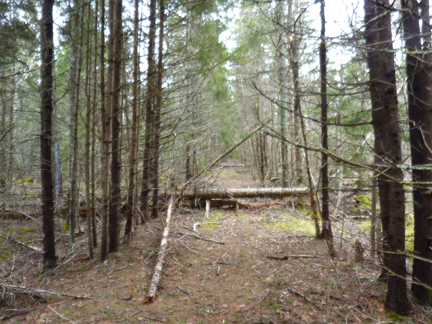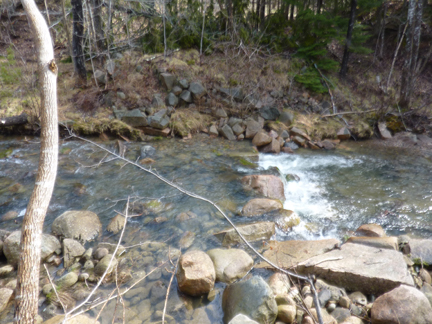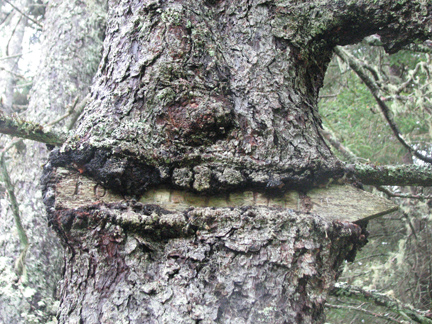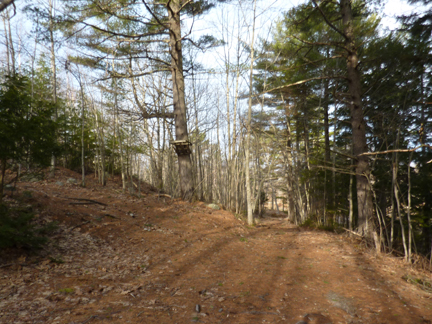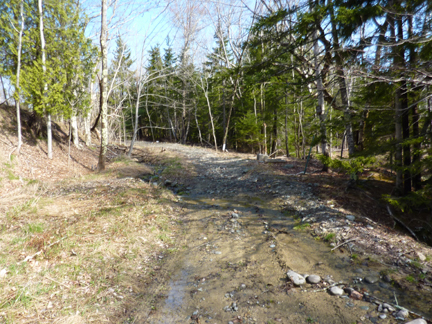Abandoned road near the old radio base on Otter Cliffs
Roads connect us. They get us to work, bring us to visit family, and take us to distant adventures. Road trip—the words conjure an expanse of asphalt disappearing into the distance and luring one on. Roads are plowed, patched, swept and maintained so we can get where we want to go. Part of our infra-structure, they seem permanent. I live on a simple village street, Grover Avenue, and cannot imagine it disappearing.
Roads do disappear, however. There is not a town in this country that doesn’t have abandoned roads. Once traveled daily, these roads are now devoid of purpose. Trees creep in from the sides, the surface cracks and vegetation emerges. Rocks, branches, and debris fall on the road and are not removed.
Roads are closed and neglected for a number of reasons. A sharp corner might be smoothed and straightened, leaving a curved section frequently renamed with the qualifier “old.” There is Old County Road, Old Goose Road, Old Turnpike and Old River Way. If there are no homes on the section, it very quickly becomes unpassable. I once lived on Winthrop Road in Deep River, Connecticut. It was straightened, and a beautiful stretch that curved along a marsh was bypassed. No one lived on that section, and so no one drove on it. Taking it one day for nostalgia I rounded the curve by the marsh, and braked. A card table with blue paper tablecloth, candle in a jar, and a few food stains blocked the way. Some cheeky celebrants risked the random driver, and held their party right in the middle of the road.
Other roads become uncared for if they no longer go anywhere. A straight, tree-lined path leads to what was once the naval communication center near Otter Cliffs. The facility was moved to a neighboring town, and the road then simply went to an abandoned site. It too became abandoned. The wooden sign pointing the way down the road to Otter Point has grown into the tree it was mounted on and looks like it has bark lips devouring it with a gruesome grin.
Closed roads are derelict, uncared for, unused. They beckon, raise questions, and connect us with the ghosts of those who once traveled these routes daily. Their history is palpable. A footpath along the Narraguagus River is wide and tucked closely to the river bank. It is an excellent spot for watching eagles and osprey feeding, a mink dodging along the rocks, and the silver splash of returning alewives. But looking at the way the flat wide surface was dug into the hillside revealed it was once a road. We followed it until it intersected with a old rail road line. There were traces of it on the other side, but that section had not fared so well, and we soon gave up and returned to bird watching.
My road may someday be an overgrown trail with remnants of foundations, or it may have vanished under the weight of development. It has already begun to recede from regular use. It was once the main road connecting the villages on either side of Otter Creek. After a steep hill below my house, called Ben’s Hill, the road passes the head of Otter Cove and then twists along, following Main Brook. Fifteen years ago is was passable by a car you did not care too much about. Today a rugged vehicle can make it to within sight of where it rejoins the new main village road, but is no longer passable. When I moved here, it was a through street. Now, I live on a dead end.
It takes so little time for a road to change from a daily part of life to a mysterious path drawing us in. It disappears in the distance, behind encroaching branches or around a corner. It asks us to remember that it once hummed with activity and ably provided a way for people to get from one place to another.
Sagging bridges, mossy foundations, weathered signs, they are all there, on the road less traveled. Wander one, and listen.

